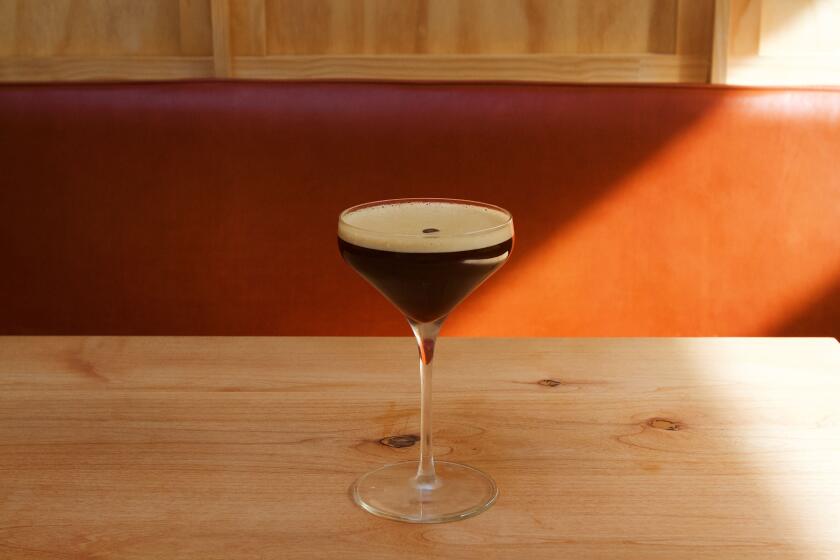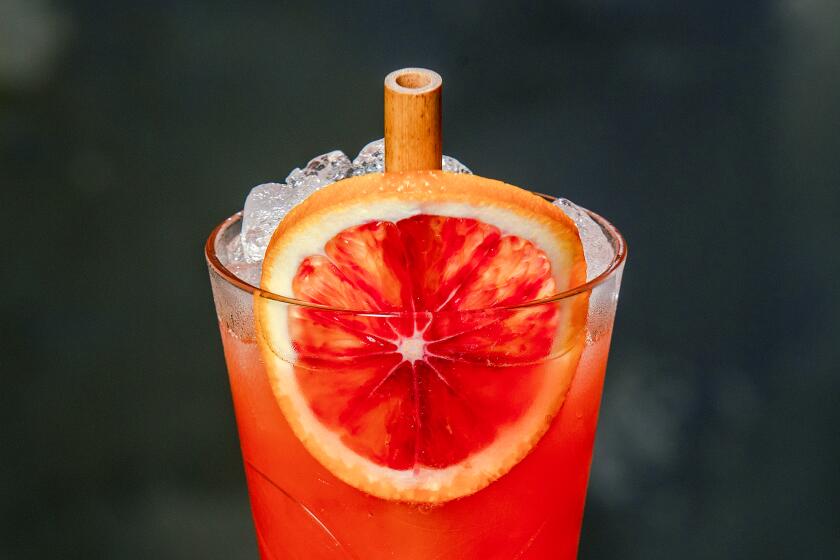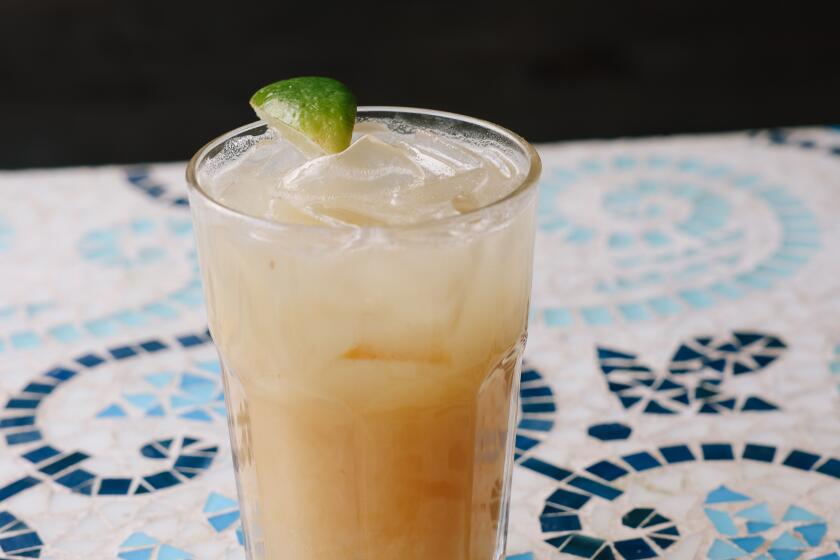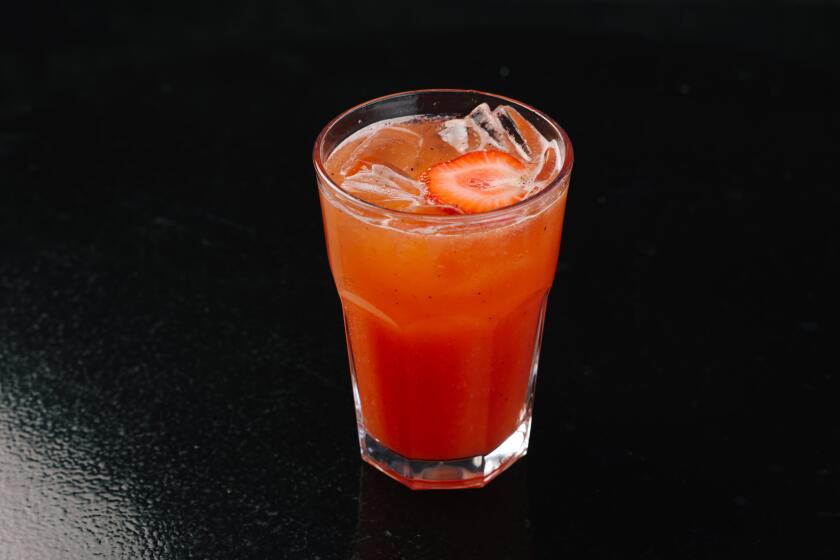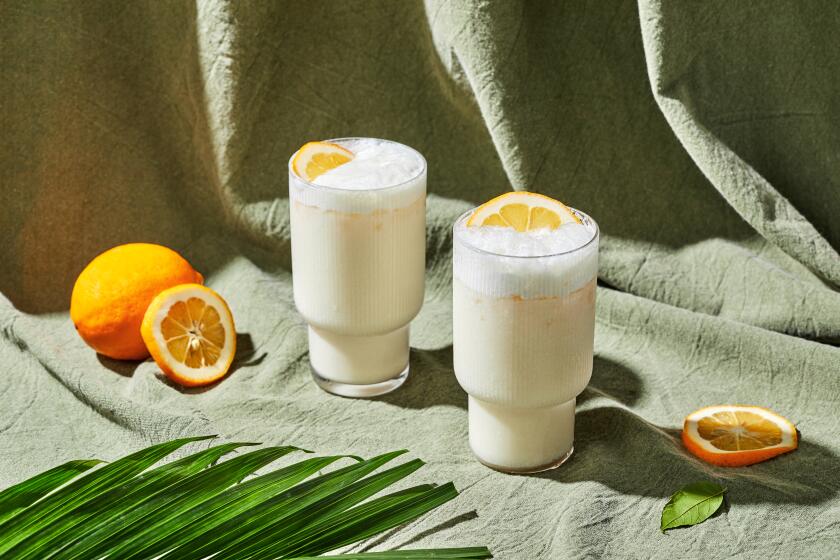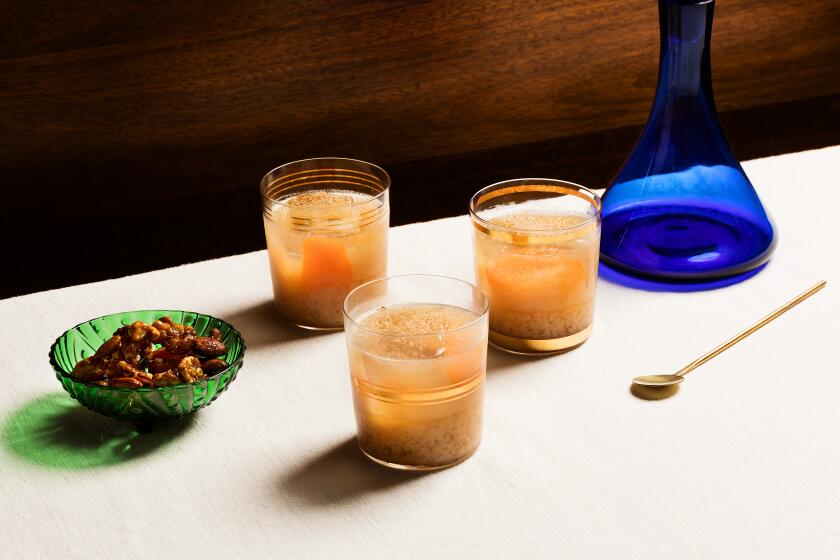Purple Rain
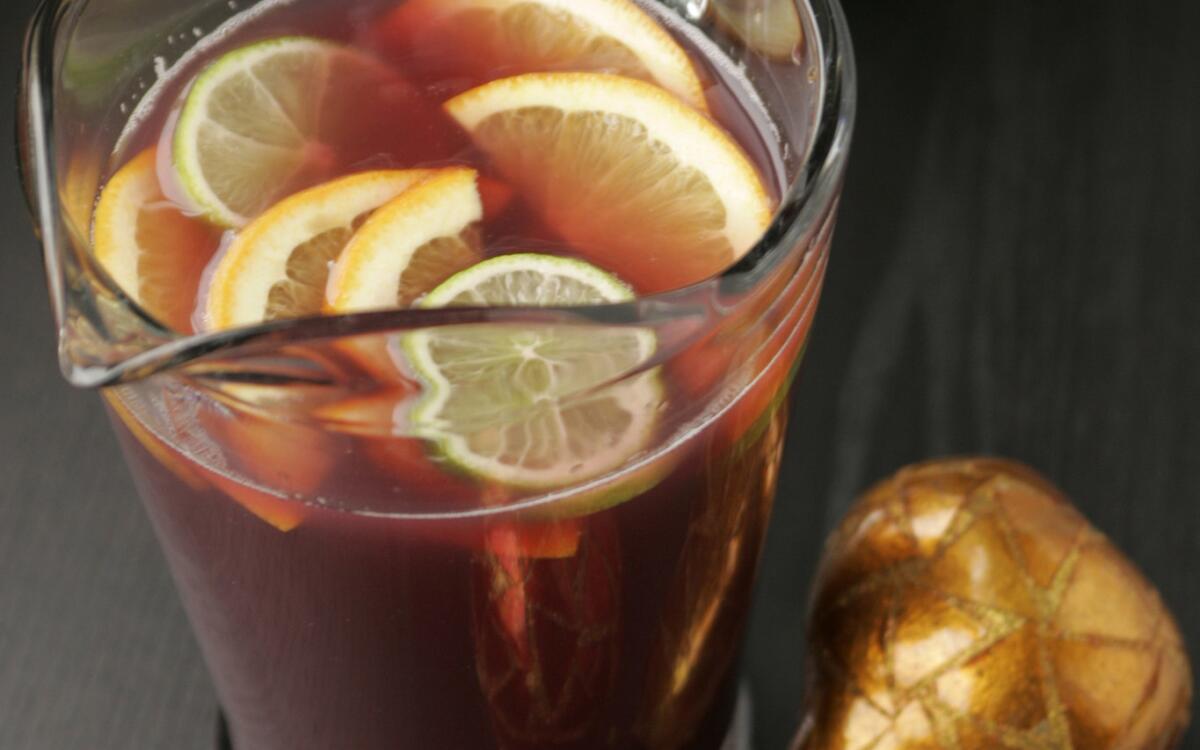
- Share via
Opening up your home for a holiday party is one of life’s great pleasures. It’s also an irresistible opportunity to serve some of the exciting wines and fancy cocktails you’ve been wanting to try.
Sophisticated aspirations are great. But how do you set a holiday bar without going crazy, broke or both?
To make things even more challenging, it’s the season when guests hop from party to party, arriving at your place any ol’ time. Your bar not only has to handle a crowd, but the drinks also need to stay fresh for the duration of the open house.
To be the party giver who sets the lofty standard by which everyone else’s party is measured, consider a little restraint. True elegance appears effortless.
“With a simple bar, you can save money by avoiding the unnecessary extras and then buy better quality of whatever you serve,” says Peter Birmingham, the sommelier at Norman’s in West Hollywood. “Trust your own palate, then find a good retailer who will steer you in the right direction.”
As far as wine goes, that means one bubbly, one white and one red. A special house cocktail adds character. And everyone appreciates a plentiful supply of bottled water -- fizzy and flat -- to quench their holiday thirsts. Offer a couple of bottles of Italian or French syrups in flavors such as cassis or hazelnut to add to fizzy water, and kids and non-imbibers will be happy too.
The trick is to set it all up in a self-tending bar that remains elegant even when you’re busy ushering folks through the buffet line. You may have time to pour the first drink for your guests, but after that, things should be set up so they can help themselves.
*
Bubbly on a budget
Greeting guests with a flute of bubbly is a festive tradition that needn’t bust the budget. While a good Champagne will set you back at least $25 a bottle, there are wonderful sparkling wines that cost half as much. Try those from Limoux in the south of France, a region that was producing sparkling wines before Champagne, says Randy Clement, a sommelier at Campanile before opening Silverlake Wine. Domaine J. Laurens is a popular house.
Cavas from Spain’s Penedes region are another good choice, Clement says. Marques de Alella makes a nice one for about $12. For afternoon parties, La Terza’s wine director, Claudio Blotta, is a fan of Bortolotti, a dry, nonvintage Prosecco available for about $15. To avoid giving guests bubbly-choice overload, it’s best to pick just one.
For nonbubbly white, Chris Meeske, a former Patina sommelier who now owns Pasadena’s Mission Wines, likes Austrian Gruner Veltliner. “These wines are dry, crisp and clean with refreshing acidity,” he says, and often a wonderful minerality. Spanish Albarinos are another of Meeske’s favorite whites. “They are lively and dry with a fruitiness that makes them amazingly versatile. Gruner Veltliners and Albarinos range from $10 to $20 a bottle.
La Terza’s Blotta recommends Verdejos from Spain’s Rueda region, while Silverlake’s Clement likes whites from Gascogne, made from the Ugni Blanc grape. There are several quality producers, he says. “It’s our most popular white wine now.”
Or consider Vouvrays from the Loire Valley, with their bracing acidity and a price tag below $15 a bottle. They’re “the last great under-valued wines,” says Randy Kemner, owner of Wine Country in Signal Hill. But his current favorite white wines for parties are the $10 and under Torrontes from Argentina, which he says are simple but not ordinary, “charming soft wines with lovely aromas.”
After you’ve picked a white, look for a red. Riojas are on Blotta’s short list, along with Malbecs from Argentina. The Altos Las Hormigas 2004 Malbec is “rich and jammy and under $10,” he says. Meeske’s overwhelming preference for a party red is any 2003 Cotes du Rhone in the $10 to $20 range. “They have the Christmas spices, cinnamon and clove, plus the silkiness of Grenache,” he says. “This vintage is exceptional.”
Or a Grenache from the Navarra region of Spain, suggests Clement. They’re distinctive, with lots of white pepper flavors, and easy to find for less than $10.
*
California highs
Sommeliers aren’t, however, recommending California wines for holiday parties. They’re typically more expensive for comparable quality, and the intoxicating effects of the high alcohol levels tend to sneak up on people. A wine with less than 13% alcohol is easier to handle than one with 14% or more.
So how much wine should you buy? The rule of thumb for wines (including the sparklers) is to expect each guest to drink half of a bottle -- roughly three drinks -- during an evening, according to sommeliers and wine store owners. With sparkling wine, if you fill the flute about two-thirds full, you’ll get six servings per bottle. Have enough on hand to offer at least one glass to each adult.
If you are also offering cocktails, many guests will drink one, then switch to wine, says Birmingham. In that case, calculate one-third of a bottle per guest for wine. If it’s a livelier crowd, Clement suggests estimating five drinks per guest. In any case, better to overestimate than underestimate: Wine and alcohol mixers have long shelf lives. As long as you buy only what you personally enjoy drinking, you’ll consume it sooner or later.
How do you know whether guests will drink more red or more white? You don’t. So buy equal quantities and then pad your purchase with an extra bottle of each, suggests Birmingham.
If you’re serving bubbly, the one thing you really can’t do without is Champagne flutes. There’s no good substitute. But you needn’t spend an arm and a leg: Inexpensive glass flutes are sold by the box at Cost Plus World Market, Pier 1 Imports and Target. Buy a few boxes just for parties.
When it comes to wine glasses, though, rules have been relaxed. Riedel, the crystal stemware company, has popularized stemless wine glasses. Riedel’s crystal tumblers can bust your budget, but the good news is that their popularity has opened the door for serving wine in any short, rounded tumbler you might have around the house, says Mission Wines’ Meeske. Even better, you can use the same short tumblers in place of old-fashioned glasses for cocktails or non-alcoholic drinks.
You’ve chosen the wines, chilled the whites and bubbly. Now how to serve them? Unless you’ve hired waiters to replenish glasses, you’ll want to open a couple of bottles of each wine and keep them on the bar, ready to pour.
Don’t stick the white wines in an ice bucket. Dripping bottles make a mess, not only of the bar but of your friends’ party clothes. Instead, slip a frozen wine sleeve over the opened bottles. To avoid drip stains from red wines, use the disposable Mylar curls that the pros use at wine tastings -- you can pick up five for $3. Roll one up and slip it into the top of a wine bottle for a cleaner pour.
*
Just add juice
House cocktails can set the tone for a party as much as the wines. But no host has time to stand at the bar mixing drinks. The best party cocktails are those that can be premixed. Serve them in a pitcher without ice -- that way they can sit on the bar for the duration.
Fruit juices with vodka are today’s mass appeal concoctions, says Dennis Lynn, head bartender at Wilshire in Santa Monica. Because it’s not too alcoholic, his Purple Rain, made with pomegranate and pineapple juices, is a hit at the restaurant, and a great choice for an open house cocktail. And he likes to keep the fruit flourishes to a minimum. “We’re not in a garnish era,” says Lynn. A few slices of lime and orange floating in the pitcher is enough.
Which vodka should you choose? “All vodkas cost 25 cents to manufacture,” says Norman’s Birmingham, so don’t fall for the “super premium” brands. Still, your guests will drink more vodka than any other spirit, he says. So stock up on tonic and cranberry juice as well as martini olives and lime wedges.
Matt Duggan, the bartender at Patina, makes Boston Sidecars this time of year with red cranberry juice. They’re lighter than many cocktails -- one part alcohol to two parts juice -- and the distinctive warmth of brandy enhanced by the sweet orange flavor of Cointreau tastes right for the season.
A Golden Pommes is one of Providence bartender Vincenzo Marianella’s favorite cocktails these days. Equal parts apple juice and bourbon, flavored with Amaretto di Saronno and fresh lemon juice, it’s a sweet drink with delicious bite.
If you expect each guest to have one of your house cocktails, remember there are about 25 ounces of alcohol in each 750 milliliter bottle, and most recipes average 2 ounces of alcohol per drink, so figure about 12 drinks per bottle.
While ice buckets and tongs seem like standard equipment for your bar, there is a simpler solution. Tongs are awkward to use, sending ice flying across the room more often than into your glass. Instead, use a wide ice bucket filled half full with ice, allowing guests to scoop up the ice directly with their glasses (or you can put a tumbler in the bucket so they get the idea). Toward the end of the party, as the ice melts, have a cocktail strainer handy to drain off any water.
If vodka is the spirit of choice, what else should the simply elegant bar include? Gin for martini drinkers, says Birmingham. And scotch for those who like something on the rocks. Bourbon is a regional preference for those who hail from the South.
Now all you need is plenty of little cocktail napkins.
The bar is open.
Pour the vodka and the pomegranate and pineapple juices into a glass pitcher. Stir with a long spoon.
Add the lime and orange slices; stir. To serve, pour over ice into tumblers.
Get our Cooking newsletter
Get a taste of Los Angeles — and the world — with recipes and kitchen tricks from the L.A. Times’ Cooking newsletter.
You may occasionally receive promotional content from the Los Angeles Times.










